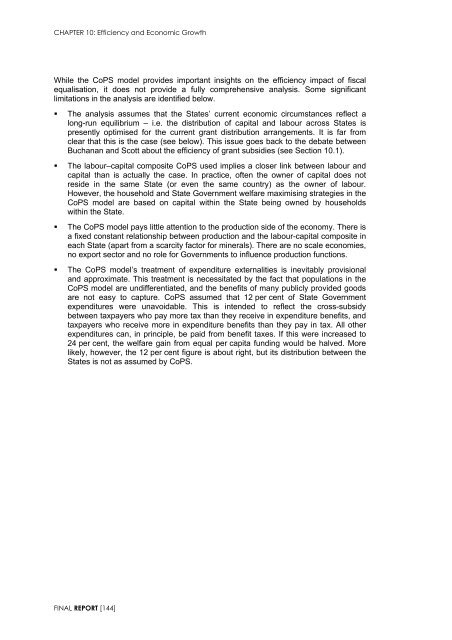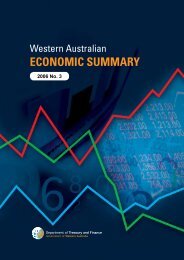Garnaut Fitzgerald Review of Commonwealth-State Funding
Garnaut Fitzgerald Review of Commonwealth-State Funding
Garnaut Fitzgerald Review of Commonwealth-State Funding
Create successful ePaper yourself
Turn your PDF publications into a flip-book with our unique Google optimized e-Paper software.
CHAPTER 10: Efficiency and Economic Growth<br />
While the CoPS model provides important insights on the efficiency impact <strong>of</strong> fiscal<br />
equalisation, it does not provide a fully comprehensive analysis. Some significant<br />
limitations in the analysis are identified below.<br />
• The analysis assumes that the <strong>State</strong>s’ current economic circumstances reflect a<br />
long-run equilibrium – i.e. the distribution <strong>of</strong> capital and labour across <strong>State</strong>s is<br />
presently optimised for the current grant distribution arrangements. It is far from<br />
clear that this is the case (see below). This issue goes back to the debate between<br />
Buchanan and Scott about the efficiency <strong>of</strong> grant subsidies (see Section 10.1).<br />
• The labour–capital composite CoPS used implies a closer link between labour and<br />
capital than is actually the case. In practice, <strong>of</strong>ten the owner <strong>of</strong> capital does not<br />
reside in the same <strong>State</strong> (or even the same country) as the owner <strong>of</strong> labour.<br />
However, the household and <strong>State</strong> Government welfare maximising strategies in the<br />
CoPS model are based on capital within the <strong>State</strong> being owned by households<br />
within the <strong>State</strong>.<br />
• The CoPS model pays little attention to the production side <strong>of</strong> the economy. There is<br />
a fixed constant relationship between production and the labour-capital composite in<br />
each <strong>State</strong> (apart from a scarcity factor for minerals). There are no scale economies,<br />
no export sector and no role for Governments to influence production functions.<br />
• The CoPS model’s treatment <strong>of</strong> expenditure externalities is inevitably provisional<br />
and approximate. This treatment is necessitated by the fact that populations in the<br />
CoPS model are undifferentiated, and the benefits <strong>of</strong> many publicly provided goods<br />
are not easy to capture. CoPS assumed that 12 per cent <strong>of</strong> <strong>State</strong> Government<br />
expenditures were unavoidable. This is intended to reflect the cross-subsidy<br />
between taxpayers who pay more tax than they receive in expenditure benefits, and<br />
taxpayers who receive more in expenditure benefits than they pay in tax. All other<br />
expenditures can, in principle, be paid from benefit taxes. If this were increased to<br />
24 per cent, the welfare gain from equal per capita funding would be halved. More<br />
likely, however, the 12 per cent figure is about right, but its distribution between the<br />
<strong>State</strong>s is not as assumed by CoPS.<br />
FINAL REPORT [144]

















